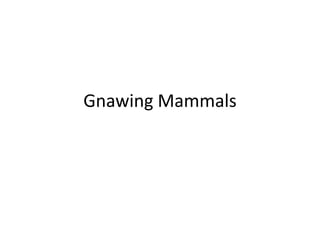Gnawing mammals
•Als PPTX, PDF herunterladen•
1 gefällt mir•1,810 views
Melden
Teilen
Melden
Teilen

Empfohlen
Weitere ähnliche Inhalte
Was ist angesagt?
Was ist angesagt? (20)
Female reproductive system of Birds, reptiles and mammals

Female reproductive system of Birds, reptiles and mammals
Mehr von Fauquier Horticulture
Mehr von Fauquier Horticulture (20)
Gnawing mammals
- 2. Mammals Warm blooded Have a bony skeleton Have a coat of hair Babies drink milk secreted by mothers mammary glands Viviparous - Young are born live (not in eggs)
- 3. Types of Gnawing Mammals Rodents: consists of the following families: Mice, rats, voles Squirrels Marmots & prairie dogs Porcupines Beavers Rabbits, hares, & pikas
- 4. Characteristics of Rodents 4 large incisor teeth Teeth never stop growing Double layers Front edge is sharper than back edge Self sharpen with gnawing Must gnaw to keep teeth worn down
- 5. Gnawing mammals Herbivores Major prey species r-selected population growth Numerous off-spring Low parental care Early reproduction Short life-span & high mortality Maximum population below carrying capacity